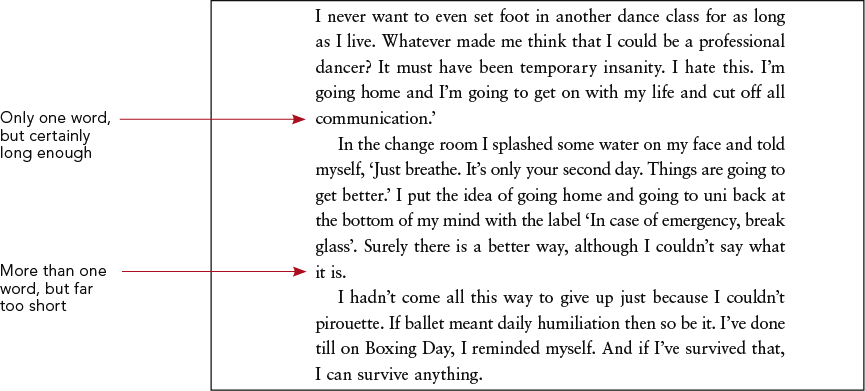Article
The mistaken identity of the widow and her orphans
The unpopular typographical widow is frequently misidentified. The most recent printed edition of the Australian Style Manual contains an archetypal definition:
In formatting for print, if a paragraph is split after its first line at the bottom of a page [or column], the single line left there on its own is called an ‘orphan’. When the last line of a paragraph starts a new page [or column], it is said to be a ‘widow’.
In typesetting and compositing terms, this has been the universally accepted definition for decades. Adobe refers to them with the same definition. The equivalent definition appears the The Chicago Manual of Style and Robert Bringhurst’s Elements of Typographic Style, first published in 1992 – and I am certain I will soon discover a reference much earlier than that. (Just after I finish reading The Surgeon of Crowthorne – again.)
Mistaken definitions can be found on well-known websites such as Fonts.com. This has nothing to do with Fonts.com – the mistake is with the individual who wrote the article. This underscores the issue in the bigger picture. It is only the grapevine of the internet that has caused confusion about the definition. Look in any printed reference which predates the internet and the definition will be consistent and unambiguous.
Nonetheless, it is easy to see why widows and orphans get mixed up. How do you remember which is which? Here’s some common memory tools:
- ‘An orphan has no past; a widow has no future.’
- ‘An orphan is left behind; a widow goes on alone.’
- Widows appear at the top of the family tree and the top of the page.
- Widows are taller than orphans.
Although there may be confusion about their definition, everybody can agree that widows and orphans are undesirable layout issues. At Bookhouse, we spent many years perfecting typography to all but eliminate both of them. For us, these problems are virtually nonexistent in our typesetting, so we rarely find the need to refer to them at all.
But we do see these terms used elsewhere in publishing. The term ‘widow’ is used to refer to the situation where the last line of a paragraph has an isolated word – regardless of where the line appears on the page. We also sometimes see it called ‘orphan’. It’s neither.
That dastardly word that hangs off the bottom of a paragraph on its own is called a ‘runt’.
The good news is that nobody needs to remember which is which because true widows and orphans are a thing of the past and the problem that none of us like has a completely different name. Phew!
The runt is a thing and nobody likes it
Putting aside the confusion about those other words we no longer need to remember, this seems like a great opportunity to look at the underlying problem in more depth. After all, a runt is a very real layout problem nobody likes.

At Bookhouse, we tend to call them ‘short lines’ instead of runts. ‘Runt’ makes it sound like a single isolated word is wrong in every instance; in many cases, they go unnoticed. Conversely, simply having more than one word on the last line of a paragraph does not necessarily indicate good composition. Consider these examples:

A long word on the last line of a paragraph, such as ‘communication’, may not be a concern for many publishers. On the other hand, two short words such as ‘it is’ may be undesirable. Simply counting words is not a robust definition.
A short line is sometimes briefed as a word less than a certain number of characters, such as eight. But what if the word is ‘illicit’? The word ‘mummify’ is the same number of characters but much wider. Defining a short line as a minimum number of characters does not work in all situations, though it is a good place to start when establishing house style. Eight, nine or ten characters will cover many instances. It may sound tempting to specify a big number as the minimum, but loose lines will be a consequence.
At Bookhouse, when we looked closely at the problem we realised the issue was really about how much horizontal space the line occupies, regardless of word count or character count. We noticed that lines which were shorter than the subsequent paragraph’s first-line indent were the ones which stood out. We also noticed that once a line occupied more than twice as much space as the subsequent first-line indent, the unusual visual properties diminished significantly.

This way of defining short lines works well with varying sizes of first-line indent. Designers may intentionally exaggerate the first-line indent to achieve a certain look and feel. Comparing the length of the last line in relation to this indent, regardless of the number of words, is a robust way of defining a short line.

These examples emphasise the need to look at the problem beyond the simple case of an isolated word on the last line of a paragraph.
Though it is useful to establish a house style for short lines so that typesetters may deliver a more refined layout, any line which jolts the attention may be considered a runt. It will often depend on the setting of rest of the page. Mark them up and we’ll fix them – just don’t call them widows!
Bookhouse’s definition of a short line (or runt) could be written as:
‘a line that is shorter than twice the subsequent paragraph’s first-line indent’.